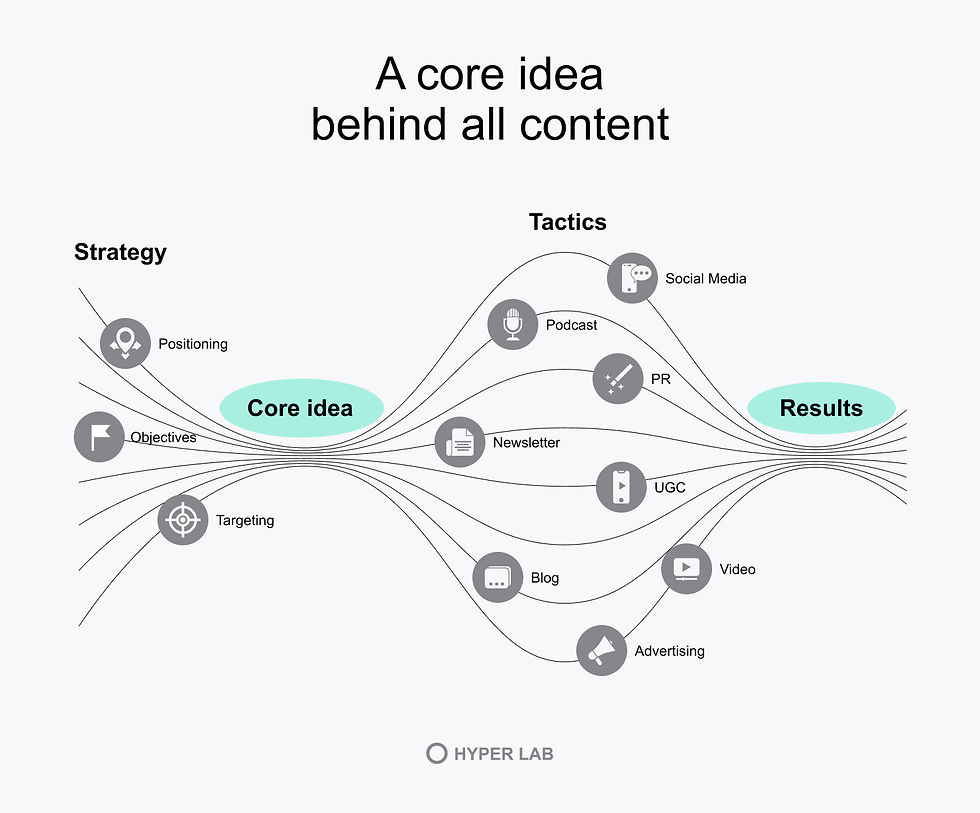SHARE IDEAS, NOT CONTENT
- Alexandra Dimofte
- Aug 26, 2024
- 6 min read
Updated: Jul 7
The future belongs to the brands that have something to say

It doesn’t take more than three clicks on the top results of any Google search to realize they all contain the same information, reworded, reassembled, and repackaged into something that seems new but isn’t.
It’s the easy route to traffic — an information patchwork that normalizes plagiarism and turns the internet into a never-ending stream of copies and copies of copies, all because too many writers chose quantity over quality.
A 2016 study by martech company Beckon showed that the volume of content published by brands had grown by 300% compared to the previous year, yet audience engagement remained flat. What’s more, 5% of the content generated 90% of interactions, meaning 19 out of 20 pieces had minimal or no impact.
Eight years later, with LLMs beginning to replace human writing, HubSpot reports that 73% of visitors to company blogs skim instead of reading thoroughly, compared to just 39% on news websites. The issue, often blamed on changing media consumption habits, is ultimately one of relevance.
In the noise created by “complete A to Z guides” and endless lists of tips, tricks, and secrets, companies are losing more than they’re gaining. They’re losing the chance to stand out, to bring their consumers closer, and to make the leap from “just another company” to “a brand.”
One brand, one idea
“We want to be recognised as industry experts.” “We want to be a relevant source of information.” “We want to be the voice people know and trust.” The difference between copy-paste content and content built around a key idea isn’t just about the material itself, it’s also about the motivation behind it.
A content strategy designed with the future in mind avoids the short-term lure of traffic in favor of building long-term credibility. It educates, inspires, and attracts the right clients. The advantage, once an audience is built and a relationship is established, is the ability to sell more, faster, and at higher prices.
That journey begins with clear positioning and a key message that anchors the company in the mind of the audience. Branded content, whether an Instagram post or a documentary film, is created to communicate that same message again and again until it sticks. The tactics may differ and the channels may vary, but the common thread running through all communication remains the same.

With their eyes fixated on keyword lists and “trending” content, companies drift away from their core message and hitch themselves to whatever everyone else is doing. Today an article about X, tomorrow a post about Y. Buried under dozens of messages, consumers remember none of them. Tactics don’t serve the strategy; they mask its absence.
The most important ingredient in the success of a content project isn’t the value of each individual piece, but the core idea that governs them all. When we treat communication as a vehicle for that central idea — rather than a collection of fragmented messages — we gain clarity, memorability, and a more powerful impact.
The message is beginning to echo — not just in clicks and likes, but in people who understand, remember, and repeat it. Now reflected in conversations with the sales team, in social media comments, and even in the language of competitors, the idea that distills the company’s positioning is fueling the leap from traffic to audience.
The same, but different
It takes only a few seconds to recognise a Guy Ritchie film. The rapid editing, stylized shots, and dark humor immediately tell us we’re in his creative universe. The same happens with George Orwell’s sentences, Andy Warhol’s contrasts, and Pink Floyd’s chords.
Creators in every art form have woven their philosophy into their style, offering the world something deeply personal — an idea, an approach, a way of doing things that could belong to no one else. In marketing communication, the principle is identical: the message is unique, the language is distinctive, the brand is the author.
With every ad, every article, every post, the challenge is to be always the same, yet different. Another chapter of the same book, another doorway into the same world.
The source of inspiration can’t be a digital marketing tool. But there are other kinds of tools brands can use to create something new (the content) to communicate something enduring (the core idea).
Stories. The oldest — and perhaps most powerful — vehicle for messages, stories blend information with emotion and embed brand communication in long-term memory. They can originate within the company (from founders, team members, or clients) or outside it, when other characters better embody the brand’s essence.
Data. From surveys that uncover key industry insights and earn PR coverage to creative executions like Spotify Wrapped, original data can drive both relevance and distinctiveness by combining multiple tactics into a single, memorable campaign mechanic.
Analysis. Explains current trends or current events, offers fresh perspectives or in-depth information, and demonstrates the company’s expertise.
Contribution. Builds on an already accepted point of view but opens up a new angle. For example, we might agree that “the size of the marketing budget plays a big role in a company’s competitiveness”, but we can also add that “one of the most powerful multipliers of that investment is creativity”.
Debunking truisms. Challenges conventional thinking where oversimplifications have erased important details and nuance. Sometimes, “annual strategies are a bad idea”, “exponential growth is a myth”, or “goals aren’t as important as they seem”.
Concepts. The most challenging, yet most valuable path to building a reputation. SparkToro was the first to introduce “zero-click content”, Backlinko popularized the SEO “Skyscraper” technique, and Freshpaint is now synonymous with “privacy-first marketing”. Each of them enriched the industry’s vocabulary and created concepts they can no longer be separated from.
Fusing concepts. The Agile philosophy applied to parenting, SWOT analysis used in personal development, a military tactic adopted in business strategy. Transferring an idea from one domain to another doesn’t just offer a fresh angle; it creates the opportunity to see an old topic through a new lens.
The network. For a medical clinic, an education provider, or a VC fund, the company’s very setup is an asset for content creation. Their network of experts — whether doctors, teachers, or entrepreneurs — becomes an endless source of educational content and insightful information that goes beyond the surface.
No matter the path, the destination remains the same: it’s not just interesting content that matters, but content that conveys the core idea in an engaging way. And to keep expressing that idea endlessly, the way we select, develop, and connect ideas needs to change.
The idea incubator
At first glance, writing is creativity. We love catchy headlines, strong openings, and vivid imagery. But these are also what make us forget the hard truth of the industry: a good idea can survive poor writing, but good writing can never save a poor idea.
And yet, in content marketing, ideation is just another task. It usually happens once a month and ends with a full editorial calendar. Often, it lasts only a few hours, during which the chance of inspiration is smaller than the risk of resignation.
We can’t escape the sepia-toned maze of easy ideas without a new system, one where ideation is a continuous process because inspiration can strike anytime, anywhere, often outside of working hours.
An “idea incubator” can be as simple as a Google Docs file that gathers fleeting observations, half-formed thoughts, and connections we make in a split second before they vanish. All of these can become the raw material for an idea that, in a week, a month, or a year, matures and is ready to be published.
The idea incubator is not just a remedy against forgetting; it’s also a space where ideas can grow and develop. A fragment of an idea saved today can be enriched with new data a month later. Three weak ideas can combine into one strong one. Another five might be dead ends, but still important steps toward the right path.
Systematizing gives ideas time to take shape and encourages us to pay closer attention, listen more carefully, and welcome inspiration from any source. That’s exactly why the most productive incubator is collective, not individual.
The most innovative ideas emerge at the intersection of two minds. A psychologist and a designer, a doctor and a marketer, a sociologist and an economist can, together, perceive realities they’d miss alone. The most unexpected connections, the most original angles arise when concepts from distant fields overlap.
And this right here is the heart of a content project. The kind of content that sets brands apart isn’t just about ideas, but about a system that collects, connects, and gives them space to grow. When we succeed at this, the noise of copycat content is silenced. When we don’t, the brand’s voice remains unheard.

